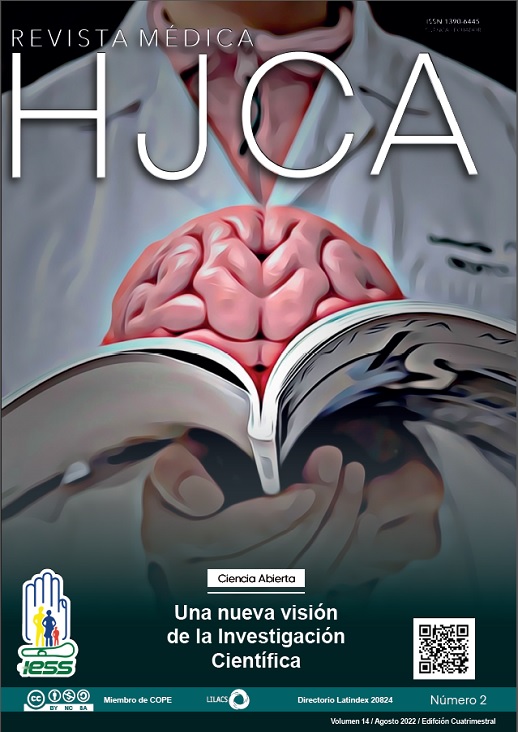Características de los pacientes con acromegalia atendidos en el Hospital de Especialidades José Carrasco Arteaga. Cuenca, 2014 - 2019
Characteristics of patients with acromegaly treated at Hospital de Especialidades José Carrasco Arteaga. Cuenca 2014 - 2019.
Palabras clave:
ACROMEGALIA, HORMONA DEL CRECIMIENTO, ADENOMA HIPOFISARIO SECRETOR DE HORMONA DEL CRECIMIENTO, ACROMEGALY, GROWTH HORMONE, GROWTH HORMONE-SECRETING PITUITARY ADENOMAResumen
INTRODUCCIÓN: La acromegalia es una enfermedad rara de inicio lento e insidioso, caracterizada por hipersecreción de la hormona de crecimiento, generalmente asociada a la presencia de un adenoma hipofisario. En Ecuador, es escasa la información sobre la caracterización epidemiológica de pacientes con acromegalia. El objetivo de este estudio fue determinar las características de los pacientes con acromegalia atendidos en el Hospital José Carrasco Arteaga desde el 01 de enero de 2014 hasta el 31 de diciembre de 2019.
MATERIALES Y MÉTODOS: Estudio observacional tipo descriptivo, transversal. Se recolectaron datos de 88 historias clínicas electrónicas de pacientes con diagnóstico de acromegalia atendidos durante el periodo mencionado. Se realizó el análisis estadístico con el software PSPP 1.4.1, se presentan los resultados de las variables cualitativas en tablas con frecuencias numéricas y porcentuales y de las variables cuantitativas se obtuvo media y desviación estándar.
RESULTADOS: El sexo masculino representó el 55.7% de la población; la media de edad al diagnóstico fue de 43.27 años. Se registró adenoma hipofisario en el 83% de casos. Los síntomas acompañantes fueron cefalea, defectos del campo visual y artralgias en el 18.2%, 27.3%, y 29.5% de pacientes, respectivamente. El 48.9% de casos recibió tratamiento quirúrgico. La frecuencia de hipopituitarismo fue de 38.6%. La frecuencia de comorbilidades fue: hipercolesterolemia (36.4%), hipertensión arterial (29.5%), hipertrigliceridemia (22.7%), diabetes mellitus tipo 2 (22.7%) e hipertrofia ventricular (11.4%).
CONCLUSIÓN: La edad media de los pacientes con acromegalia fue de 52.60 años, la edad media de diagnóstico fue de 43.27 años, fue más frecuente en el sexo masculino. En el 83% se asoció a la presencia de adenoma hipofisario. La comorbilidad más frecuente fue la hipercolesterolemia en el 36.4% de los pacientes. El 48.9% de pacientes recibieron tratamiento quirúrgico, 34.1% recibieron tratamiento combinado. El 38.6% de pacientes con acromegalia presentó hipopituitarismo; no se documentaron casos de hiperprolactinemia.
ABSTRACT
Characteristics of patients with acromegaly treated at Hospital de Especialidades José Carrasco Arteaga. Cuenca 2014 - 2019.
BACKGROUND: Acromegaly is a rare, slow-onset and insidious disease characterized by growth hormone hypersecretion, generally associated with the presence of a pituitary adenoma. In Ecuador, the information about the epidemiological characterization of acromegaly is limited. The aim of this study was to determine the characteristics of the patients with acromegaly treated at Hospital de Especialidades José Carrasco Arteaga from January 1st, 2014 to December 31st, 2019.
METHODS: This is an observational, descriptive, cross-sectional study. Data was collected from 88 electronic medical records of patients with a diagnosis of acromegaly treated during the aforementioned period. Statistical analysis was performed with PSPP 1.4.1 software. The results of qualitative variables are displayed in tables with numerical and percentage frequencies and for quantitative variables we obtained the mean and standard deviations.
RESULTS: The male sex represented 55.7% of the population; the mean age at diagnosis was 43.27 years. Pituitary adenoma was registered in 83% of the cases. The accompanying symptoms were headache, visual field defects, and arthralgia in 18.2%, 27.3%, and 29.5% of the cases, respectively. 48.9% of cases received surgical treatment. The frequency of hypopituitarism was 38.6%. The frequency of comorbidities was: hypercholesterolemia (36.4%), arterial hypertension (29.5%), hypertriglyceridemia (22.7%), type 2 diabetes mellitus (22.7%) and ventricular hypertrophy (11.4%).
CONCLUSION: The average age of patients with acromegaly was 52.60 years, the average age of diagnosis was 43.27 years, and it was more frequent in males. In 83% of the patients it was associated with the presence of pituitary adenoma. The most frequent comorbidity was hypercholesterolemia, in 36.4% of the patients. 48.9% of the patients received surgical treatment, 34.1% received combined treatment. 38.6% patients presented hypopituitarism; no cases of hyperprolactinemia were documented.

